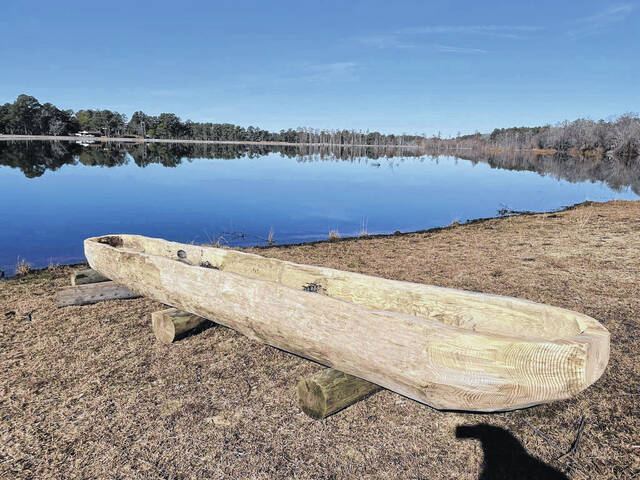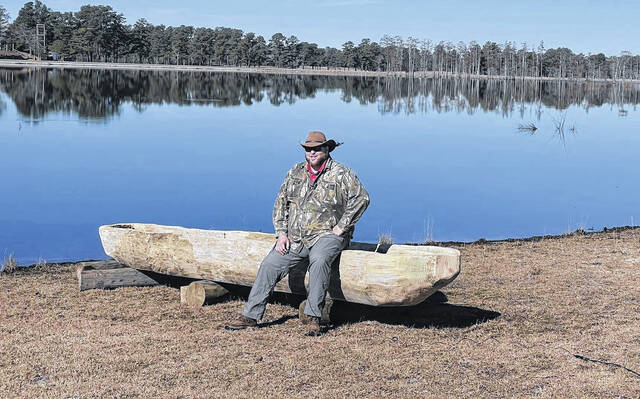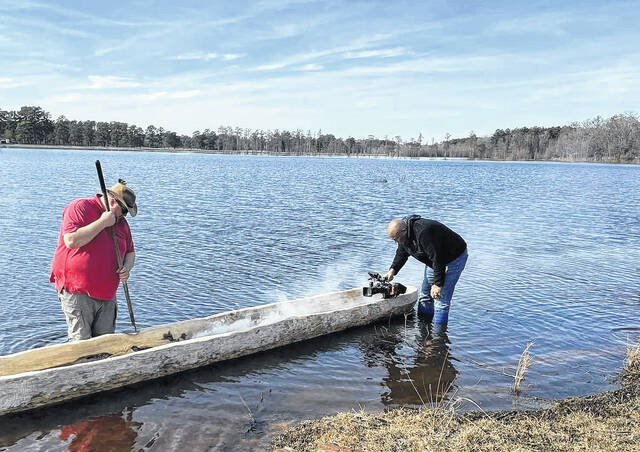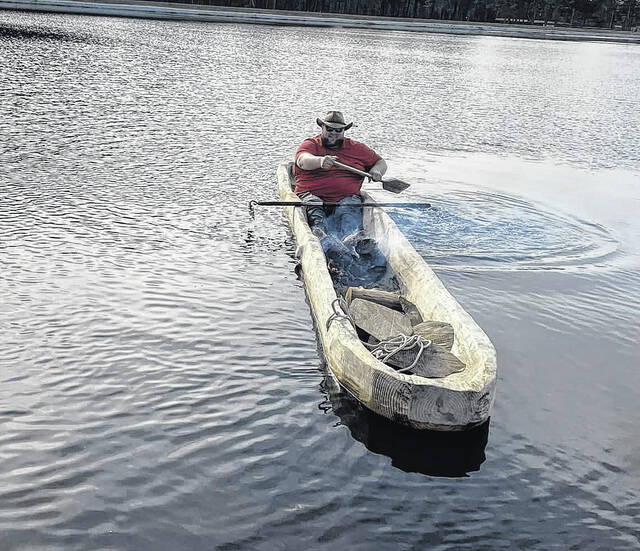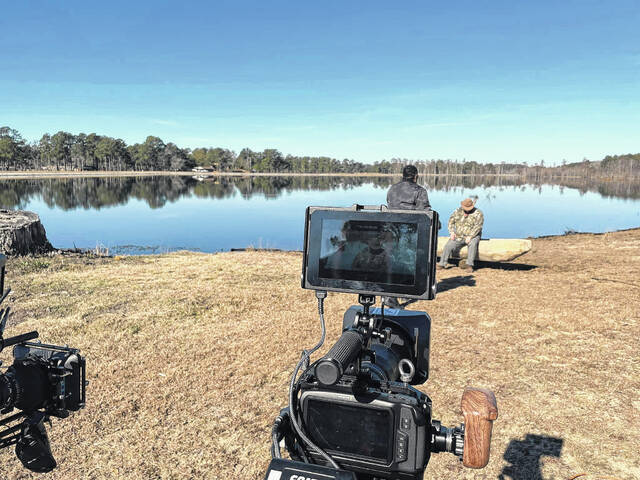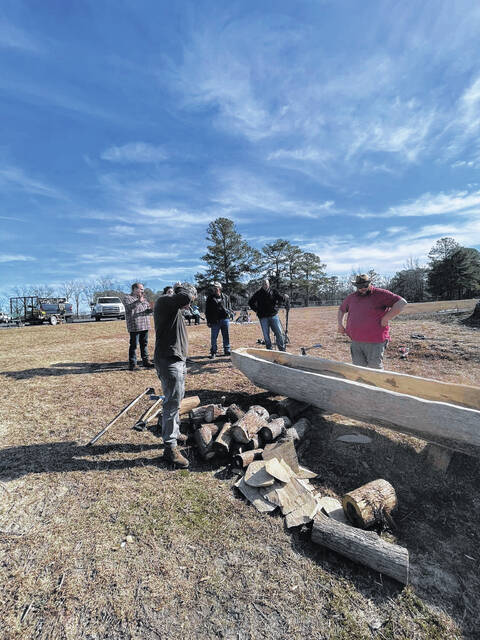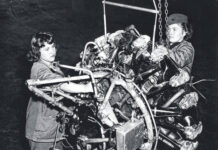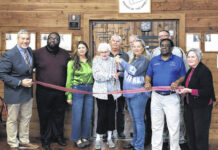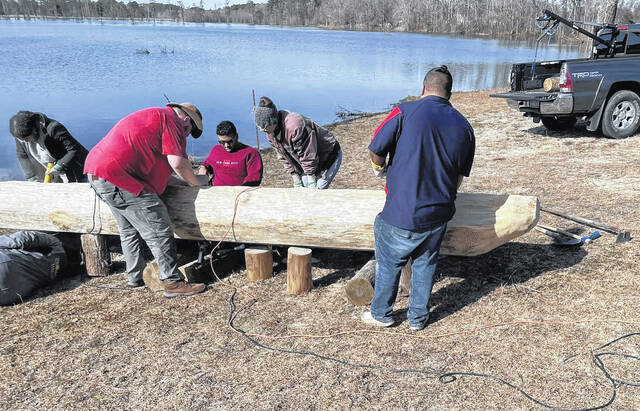
Led by Lumbee Tribal Historic Preservation Officer Kevin Melvin, people representing communities throughout the state converged at the Lumbee Tribe Cultural Center each Saturday for eight months to help construct Wisdom, a dugout canoe, by applying tools and methods done by Native American ancestors.
Modern dugout canoe to touch ancestral waters throughout NC
MAXTON — On display at the Museum of the Southeast American Indian housed in Old Main at The University of North Carolina at Pembroke, is a thousand-year-old yellow pine dugout canoe found beneath the McNeil Bridge in Lumberton in the 1980s.
“I look at our canoe every day,” said Nancy Strickland Fields, the museum’s director and curator. “I’m thinking ‘What stories do you have to tell? What experiences have you gone through? What have you seen?’ And it sits there in silence. When we started to engage in the project, I feel like that canoe has come to life even more.”
“There’s something palpable about working with historical objects and artifacts that if you listen hard enough. They’ll start sharing their stories with you and that’s what we’ve done through our actions by listening closely to our ancestors.”
A new dugout canoe named “Wisdom” will soon join the piece of history and tell its own story of North Carolina’s eight state-recognized tribes — the Coharie, the Eastern Band of Cherokee Indians, the Haliwa-Saponi, the Lumbee Tribe of North Carolina, the Meherrin, the Sappony, the Occaneechi Band of the Saponi Nation and the Waccamaw Siouan — as well at the Catawba.
Led by Lumbee Tribal Historic Preservation Officer Kevin Melvin, people representing communities throughout the state converged at the Lumbee Tribe Cultural Center each Saturday for eight months to help construct a dugout canoe by applying tools and methods used by Native American ancestors.
Wisdom was the result of their efforts and is just one component of the Life by the River Project.
Life by the River
Life by the River is a project launched by the Museum of the Southeast American Indian, with the goal of exploring North Carolina’s native people’s connection with their ancestral waters, according to Fields.
“When I say that I mean, rivers, shorelines, Carolina bays, lakes, streams, all of the above, and looking at what are our connections, how do rivers especially network us together and link us together and what role does water play in our lives as native people culturally, spiritually, historically and in a contemporary context,” Fields said.
One of the most deciding features of native people in the Southeast is that each tribe is situated along rivers.
“They have a connection to a river … In fact a lot of these rivers’ names come from native people,” Fields said.
Fields said that the tribes and the rivers are still here “so when we think about issues like identity, culture and history and even really hard contemporary topics like federal recognition. A lot of these conversations are fixed on landscapes and environments.”
With the Life by the River Program, the museum seeks to look back at that connection and dive into what has changed today.
“Our relationship is still there but it’s different than what it once was … Being connected to our water is complicated,” the curator said.
Fields cited the lack of access the Waccamaw Siouans have to Lake Waccamaw due to Jim Crow laws established nearly 100 years ago and the negative impact the Lumber River suffered because of the recent hurricanes.
“My great-great-grandmother, my great-grandmother, my grandparents, my mom use to fish that river, the Lumbee River daily for food … That was just a food source for them … That was just everyday stuff,” Fields said.
These days fishing is not as essential and access has been limited.
“Exploring them I think will really help put a different lens on who we are and how we’re connected and bring really North Carolina’s history into a different focus which I think will be really powerful,” Fields said.
The program goal is to also revive the canoe tradition with songs and ceremonies and the different things that go along with the traditional Riparian way of life, which is a system in which water belongs to those who own land along its path.
To carry out this goal, the museum will facilitate an exhibition in the fall, film a documentary and collaborate with the nine participating tribes to compose a canoe song, with a melody created by Layla Locklear Cerppel.
“The melody is what unifies the song,” Fields said.
Constructing Wisdom is the first component of the program completed.
Building Wisdom
The dugout canoe project began as part of an internship for Kevin Melvin’s graduate school program at UNC Wilmington, where he is studying public history. With assistance from the North Carolina Nature Conservancy, a large Loblolly Pine tree was found, cut, and moved to the Lumbee Tribe Cultural Center, where it was burned and dug out by teams of volunteers each week since May.
“At first I thought it would kind of be something small but it ballooned and turned into something larger than life,” Melvin said.
Melvin said that he had the idea to make the canoe as traditional as possible using the fire burn and scrape method his ancestors would’ve used.
“To my knowledge, this is the first time something like this is being done in the traditional way, probably in a couple of hundred years,” Melvin said.
“We got into it and it was taking a whole lot longer than I thought it was going to take,” Melvin said. “We ended up having to use a few modern tools but nothing major.”
Melvin does not boast himself as an expert craftsman. In fact, he admits that he relied on the knowledge of other craftsmen for assistance.
“I was completely new. Most of the people who had their hand in this were completely new — not only to making canoes but in general,” he said. “I talked with folks down in Florida, a couple of Seminole guys about how they did theirs; read books. I watched about every YouTube video there is about making canoes.”
Melvin crafted some of the tools that would’ve been used by ancestors to construct canoes like stone axes to demonstrate the level of difficulty and hard work that went into them.
“Image having to do all this work with these kinds of tools,” Melvin said. “To think the canoe the size that we made took us about eight months, traditionally our ancestors would have been able to make one that size in probably about two or three weeks. They were working around the clock. They were working in shifts. It was a communal thing … because they used these for fishing, for hunting, for traveling, for trade.”
The community component soon became the most important aspect of the project.
“We got to experience some of those communal ties. That’s really bigger than the actual canoe itself. It just brings back those communal ties,” Melvin said.
Just days before the construction on the canoe was complete, the name Wisdom came to Melvin in a dream.
“It kind of sounds hokey but traditionally that’s the way our people went about things,” he said. “We prayed about it, we mulled things over … A name has importance and the amount of wisdom that was shared throughout the process of making the canoe…”
Wisdom’s journey
Wisdom suffered some damage caused by sitting in the elements for months.
The team of volunteers moved the canoe to the edge of the Lumbee Tribe Cultural Center Lake. After some final sanding, they set it on fire one more time. The fire helps with the sanding and seals up the inside of the canoe. It was then sunk into the lake where it will remain until May. The water submersion will help preserve it.
Eventually, the canoe will travel across the state. The goal is to put it in each tribes’ ancestral waters, whether that is a river, stream, lake or Carolina bay. The museum staff and community plan to bring the canoe up in May. The inaugural launch programming and ceremony is scheduled for May 13.
The canoe will eventually be preserved and installed in the Museum of the Southeast American Indian’s Family Discovery Center.
“To actually be able to put your hands on something or even get in it or use it, something that was made in the same manner … That’s a big thing. That’s very important,” Melvin said. “It might not be 400 years old, it might not be something our ancestors put their hands on and used but something very similar.”
Visit the museum’s website for more information about Life by the River Project.
Tomeka Sinclair can be reached at [email protected] or 910-416-5865.

